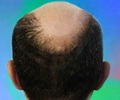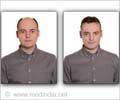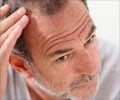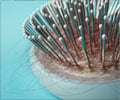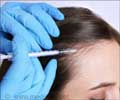- Hair loss - (https://en.wikipedia.org/wiki/hair_loss)
- Alopecia Areata - (https://www.niams.nih.gov/health_info/alopecia_areata/)
- About Alopecia areata - (https://en.wikipedia.org/wiki/alopecia_areata)
- ALOPECIA AREATA: SELF-CARE - (https://www.aad.org/public/diseases/hair-and-scalp-problems/alopecia-areata)
- Androgenetic alopecia - (https://ghr.nlm.nih.gov/condition/androgenetic-alopecia#)
- Hair Loss in Women - (http://my.clevelandclinic.org/health/articles/derm-hair-loss-faq)
Introduction to Hair Loss
Hair loss, referred to as alopecia, is a common yet distressing condition that affects young as well as older individuals.
A normal person loses around 100 hairs a day that get shed at the end of their growth cycle. But this hair loss usually goes unnoticed.
Each hair undergoes three stages of development. Around 85 to 90% of hair follicles on the head are usually in the anagen or growing stage. They remain in this stage for 2 to 6 years. This is followed by the catagen or involution phase that affects 2 to 3% of hair follicles.
The catagen phase is followed by the telogen or resting phase in which 10 to 15% of hair follicles undergo a period of rest for around 3 months. Following this stage, the hair is ejected from the skin leaving a solid, hard nodule.
Some degree of hair loss is thus normal. If there is excessive hair loss, it makes sense to first find out the possible cause so that the best treatment can be adopted.
What are the Types and Causes of Hair Loss?
The cause of hair loss may vary from a local condition affecting the scalp to an ailment affecting the whole body.
1. Androgenetic alopecia:
The most common type of hair loss is related to both the genetic and hormonal make up, and is called androgen-dependent hair loss or androgenetic alopecia. The commonly used name for this type of hair loss is male or female pattern baldness.
About 50% of children with a balding parent of either sex will become bald over a period of time. In the United States, an estimated 50 million men and 30 million women are affected by male and female pattern baldness, respectively.
Male pattern baldness runs in families and is characterized by a receding hairline, and moderate to extensive loss of hair, especially on the crown area. The hair is lost in an M-shaped pattern, with loss at the crown and temples and sparing of the sides and the back of the head.
The main cause of this condition is the presence of high amounts of the male hormone, dihydrotestosterone (DHT) within the hair follicle. DHT is produced from testosterone in the prostate, the scalp and other organs. The abundance of DHT causes the hair follicle to degrade and shortens the active phase of the hair.
Male pattern baldness is also associated with coronary heart disease, enlargement of prostate and its cancer, disorders of insulin resistance and high blood pressure.
Female pattern baldness is characterized by overall thinning of hair on the head, and a moderate loss of hair on the crown or at the hairline. Women with this type of baldness may show excess androgen levels and should be evaluated for other conditions like polycystic ovarian syndrome (PCOS) characterized by irregular menstruation, excess body hair, acne and weight gain.
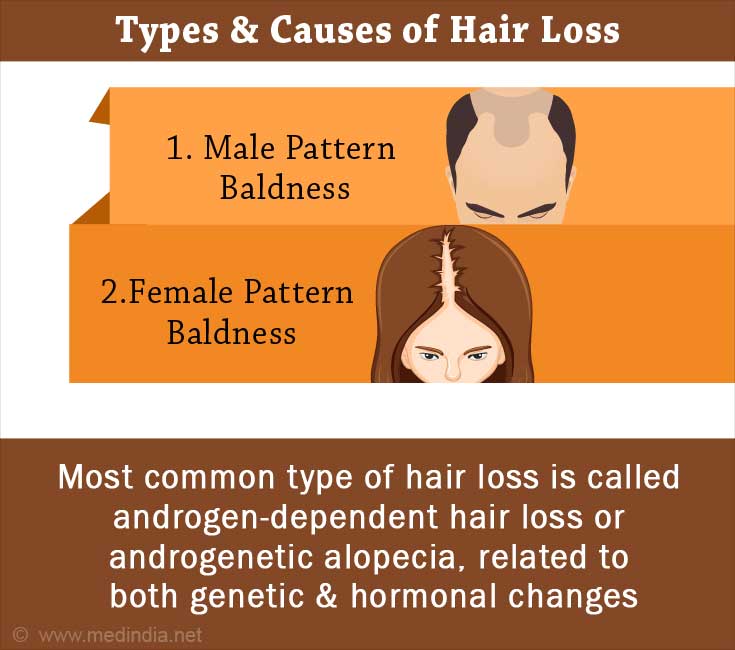
2. Alopecia areata:
Alopecia areata or “spot baldness” is a condition where the patient suffers from a localized hair loss.
When the hair loss extends to the whole scalp, the condition is called alopecia totalis. If it is accompanied by hair loss over the entire body, it is called alopecia universalis.
The hairs over the affected area resemble exclamation points, that is, the hair is thinned out but the caliber of the hair at the base remains the same. It may be associated with autoimmune conditions.
Most patients recover without treatment in 6 to 12 months. Recurrence occurs in 30% cases. Prognosis is worse if the condition lasts for more than a year, begins before puberty, is present in other members of the family or occurs in patients of
3. Telogen effluvium:
Telogen effluvium is a condition where the normal balance between the resting and growth phases of hair is disrupted, resulting in a predominant telogen phase.
Thus, it leads to excessive shedding of hair and a decrease in the total number of hair. Some of the conditions that can result in telogen effluvium are:
- Physiological stress due to a major surgery, severe illness, high fever, emotional crisis or childbirth.
- Medical conditions like an over or under active thyroid gland, liver or kidney failure
- Autoimmune diseases like systemic lupus erythematosus and dermatomyositis
- Chronic infections like HIV and secondary syphilis
- Inflammatory disorders like psoriasis, seborrheic dermatitis, allergic contact dermatitis and inflammatory bowel disorder
- Nutritional deficiencies in zinc, iron and vitamin D
- Severe decrease in protein, fat and calorie intake due to crash diets. The hair grows normally after a liberal intake of these nutrients. A high protein and an iron-rich diet is recommended for hair loss. An adequate intake of raw vegetables, fresh fruits, salads and green leafy vegetables should be included in the diet on a regular basis
- Malabsorption syndromes and pancreatic disease
- Medications like oral contraceptives, androgens, retinoids, beta-blockers, angiotensin-converting enzyme inhibitors, anticonvulsants, antidepressants, and anticoagulants.
The event may have occurred up to 3 months before the hair loss incident. Treatment of the underlying condition usually results in resolution of the hair loss. Thus, telogen effluvium is a sign of an underlying condition and not a disease by itself.
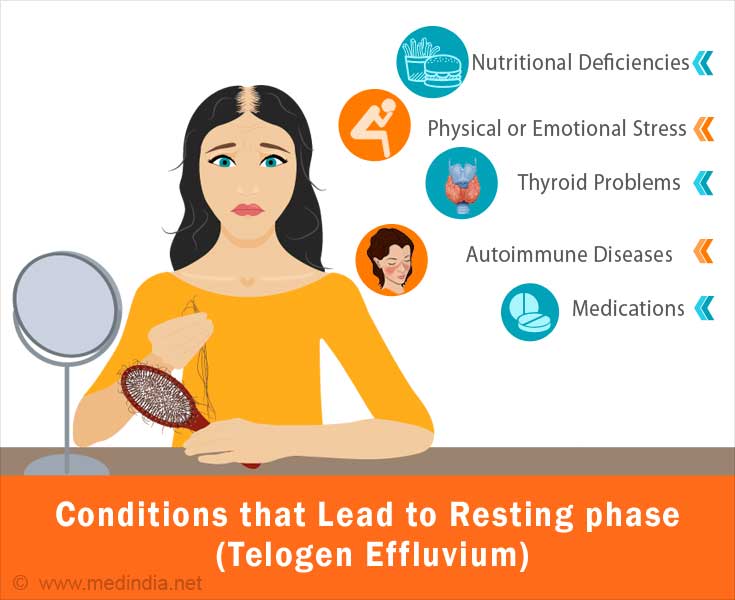
4. Anagen effluvium:
This is a loss of hair in the anagen phase that occurs due to chemotherapy, radiotherapy (radiotherapy can also cause telogen effluvium), heavy metal poisoning and boric acid poisoning.
Hair loss usually appears 1 to 2 weeks following the trigger and is noticeable by 1 to 2 months. Alopecia areata also results in loss of hair of the anagen phase.
5. Trichotillomania:
Trichotillomania is a psychiatric condition where the patient plucks out his or her own hair. It may develop between 8 to 12 years of age.
The hair loss appears bizarre, with incomplete areas of clearing. In some cases, the patient may also eat up the plucked hair resulting in obstruction in the intestines.
6. Traction alopecia:
Traction alopecia is a condition where the person suffers from hair loss due to tight tying of hair in ponytails or plaits. A change in hair style is necessary to prevent further hair loss in these patients.
7. Hair loss due to Tinea capitis:
Tinea capitis is a ringworm infection of the scalp. It is a type of fungal infection where there may be a boggy lesion on the scalp over which the hairs are increasingly fragile and break easily.
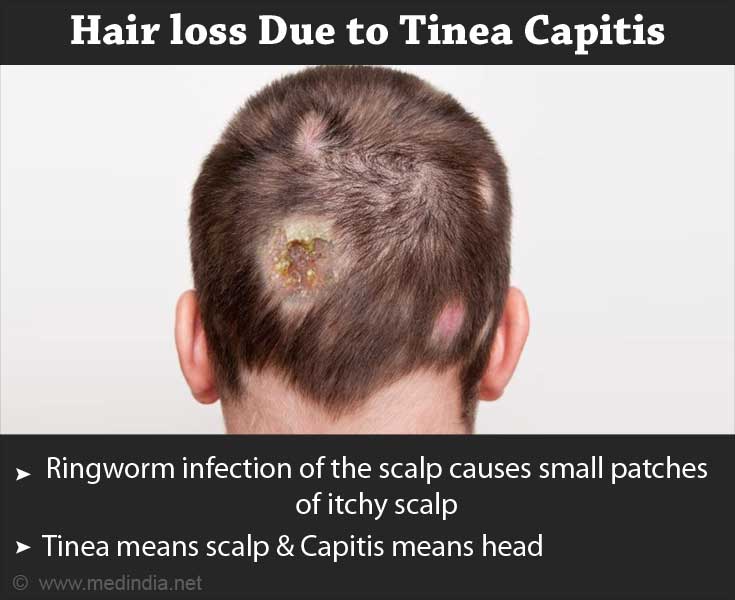
8. Cicatricial alopecia:
Cicatricial alopecia is a condition where the hair follicles are permanently destroyed, resulting in permanent hair loss.
It could be caused by a number of conditions like inflammation, autoimmune conditions like discoid lupus, and infections like cellulitis.
9. Congenital triangular alopecia:
Congenital triangular alopecia is a missing patch of hair in the shape of a triangle near the temples and occurs mostly in young children. It is a permanent condition that is contained in the same area. Causes are unknown and there is a complete loss of hair follicles in the particular area.
10. Involutional alopecia:
Involutional alopecia is a gradual thinning of the hair due to age. This occurs because hair follicles switch from the growth or anagen phase into the resting or telogen phase. Hairs become shorter and fewer.
11. Other Causes:
- Pollutants in air and water, styling products and excess sebum block hair follicles and restrict hair growth.
- Tumors in the skin can cause localized baldness.
- Stress caused due to worry, anxiety and sudden shock can affect hair and result in hair fall.
How can Hair Loss be Treated?
For Androgenetic alopecia:
A variety of drugs have been tried for hair loss. The most popular ones are minoxidil and finasteride, both of which are approved by the Food and Drug Administration (FDA). These treatments are most effective when started early. However if the treatment is stopped, the baldness returns.
Minoxidil is a topical solution that lengthens the growth or anagen phase and possibly increases the blood supply to the hair follicle. It works better on the top of the head. It is a 2% or a 5% solution that is rubbed into the scalp. Side effects are scalp irritation and allergic contact dermatitis.
Finasteride is given orally as a 1 mg pill and is used only for male-pattern baldness. It works better at the top of the head. Side effects are decreased sex drive, and erectile and ejaculatory dysfunction. It is not used in women and can cause fetal genital malformations when used in pregnancy.
Spironolactone is used for female-pattern baldness but is not FDA-approved for the purpose.
For Alopecia areata:
Alopecia areata cannot be cured but can be controlled. Hair growth can be hastened with the use of:
Corticosteroids like clobetasol and fluocinonide that are given as shots at the spots where there is baldness. A topical cream, lotion or ointment can also be applied on these spots. They work by suppressing the immune system as the cause for the condition is auto-immunity.
Minoxidil that is used in children and adults along with another treatment. It is available as a topical cream containing 5% minoxidil.
Anthralin, which is a topical coal tar preparation that works by altering the skin’s immune system.
Surgical Hair Restoration and Hair Covers:
Surgical hair restoration is the only permanent solution to baldness.
Follicular unit transplant is a traditional hair transplant method. Hair follicles are taken from places where there is dense growth and implant them in the area like the top and front of the head where there is scarce hair.
The procedure takes about four to five hours and is done using a local anesthetic.
A newer technique of micro-grafting gives a more natural appearance.
Topical hair cover like wigs or a hairpiece can be used temporarily or permanently to cover hair loss.
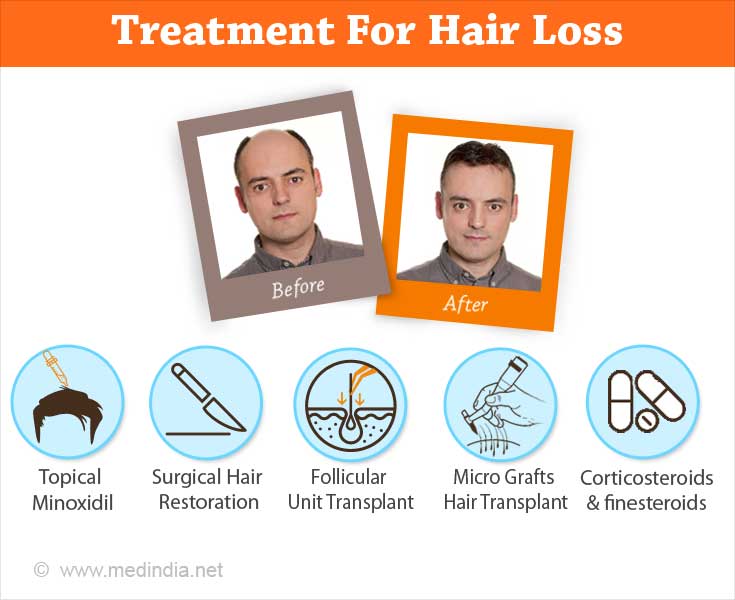
Natural Remedies
There are several natural ways to maintain healthy hair. This could involve consuming sufficient amounts of essential nutrients and applying certain external nourishments for the hair.
Hair is made of keratin, a protein, which also makes up the nails and the outer layer of our skin.
- A well balanced diet: Persons with a tendency to lose their hair should eat a well-balanced diet. Since hair contains protein, the protein intake should be adequate. An adequate quantity of vegetables, seeds, nuts, green leafy vegetables, fresh fruits, egg, buttermilk, yogurt, soybeans, cheese and milk should be included in the diet. Hair fall and premature graying can occur due to vitamin B deficiency, which should be corrected.

- Massage: Vigorous rubbing of the scalp with the fingers, after washing the hair with cold water can help hair growth. This will activate the sebaceous glands and increase blood circulation, making hair growth healthy.
- Herbs, Pulses and Oils in Hair Care: There are several herbs, pulses and oil preparations that can be made and applied to the scalp at home to stimulate and maintain hair growth. These include:
- Mustard oil boiled with henna leaves
- Refined coconut oil mixed with lime water and lime juice
- Green coriander juice
- Coconut milk
- Coconut oil boiled with Indian gooseberry pieces
- Castor oil
- A fine paste made from pigeon pea or red gram pulses
- Seeds of lime and black pepper seeds ground to a fine paste, and applied to bald patches
- The hair can also be washed with a mixture of equal quantities of fresh amla (Indian gooseberry) juice and lime juice, or with a paste of cooked black gram dhal and fenugreek seeds.



